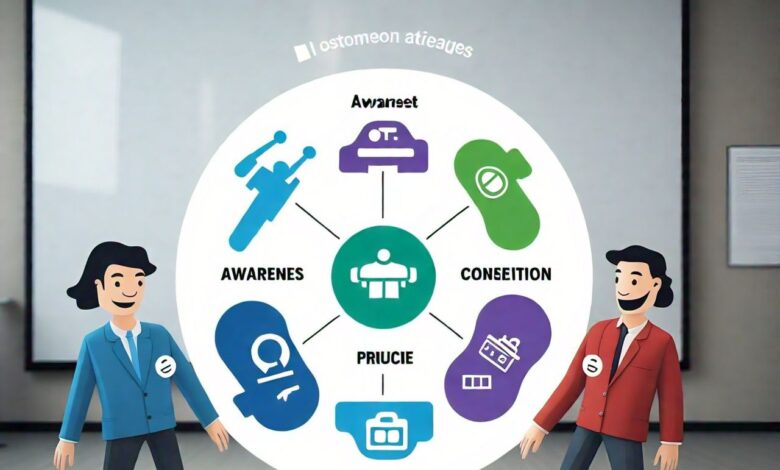The Customer Journey Explained

Introduction
Have you ever wondered what turns a casual browser into a loyal customer? The answer lies in the customer journey. It’s more than just a buzzword—it’s a blueprint for understanding how your audience interacts with your brand from the moment they first hear about you to when they become repeat buyers (and hopefully advocates). For businesses looking to refine their marketing strategies, understanding the customer journey isn’t optional—it’s essential.
Let’s break it down step by step and explore how mapping out this journey can transform your marketing game.
What is the Customer Journey?
The customer journey refers to the steps a person takes when interacting with your brand, whether they’re buying a product, signing up for a service, or simply engaging with your content. It’s not just about the final purchase—it’s about every interaction along the way.
Think of it like a roadmap. At each stage, customers have different needs, expectations, and questions. Your job is to guide them through this process smoothly and effectively. When you understand what your customers experience at each touchpoint, you can create tailored strategies that resonate with them.
The Five Stages of the Customer Journey
1. Awareness
This is the starting line. At the awareness stage, potential customers realize they have a problem or a need. They may not know much about your brand (or even that you exist), but they’re starting to explore options. Your goal here? To show up on their radar.
Content marketing plays a huge role in this stage. Blog posts, social media, video content, and ads can all help introduce your brand to potential customers. The trick is to create content that’s informative, engaging, and relevant to their pain points. Don’t push the sale yet—focus on being helpful.
2. Consideration
Now that you’ve captured their attention, it’s time to nurture their interest. During the consideration stage, potential customers are evaluating their options. They’re researching your competitors, reading reviews, and comparing products.
This is where you need to position yourself as the best choice. Testimonials, case studies, detailed product descriptions, and comparison guides can make all the difference. Personalized email campaigns and retargeting ads can also help keep your brand top of mind.
3. Decision
The decision stage is where things get serious. Your potential customer is ready to buy, but the question is: will they choose you? At this point, your job is to remove any friction that might stand in the way of a purchase.
Make the process as seamless as possible. Ensure your website is user-friendly, your checkout process is smooth, and your pricing is transparent. Offering promotions, free trials, or guarantees can also nudge customers toward clicking that “Buy Now” button.
4. Retention
Congratulations, you’ve made the sale! But the journey doesn’t end here. Retaining customers is just as important as acquiring them—if not more so. Why? Because repeat customers are more likely to spend more, cost less to market to, and refer others to your brand.
Engage your customers post-purchase. Send follow-up emails, ask for feedback, and provide excellent customer support. Loyalty programs, exclusive offers, and personalized recommendations can also help turn one-time buyers into loyal customers.
5. Advocacy
The final stage of the journey is advocacy, where satisfied customers become your brand ambassadors. They leave glowing reviews, share their experiences on social media, and recommend your products to friends and family.
Encourage advocacy by making it easy for customers to share their positive experiences. Incentivize referrals, feature user-generated content, and respond to reviews. The more valued your customers feel, the more likely they are to sing your praises.
Mapping Your Customer Journey
To make the most of the customer journey, you need to map it out. A customer journey map is a visual representation of the steps your customers take when interacting with your brand. It helps you identify pain points, opportunities, and areas where you can improve.
Start by putting yourself in your customer’s shoes. What are they thinking, feeling, and doing at each stage? Use data from website analytics, surveys, and feedback to fill in the gaps. And don’t forget to align your journey map with your marketing strategy. For example, using an SEO playbook can ensure your content is optimized to attract and engage customers during the awareness and consideration stages.
Why the Customer Journey Matters
Understanding the customer journey isn’t just about improving sales—it’s about creating a better experience. When you meet customers where they are and anticipate their needs, you build trust and loyalty. And in today’s competitive market, trust is a currency that’s hard to come by.
A clear view of the customer journey also ensures your marketing dollars are spent wisely. Instead of taking a scattershot approach, you can focus on what works. Whether it’s investing in targeted ads, crafting personalized emails, or enhancing your customer support, you’ll see a greater return on your investment.
Final Thoughts
The customer journey is the backbone of any successful marketing strategy. By understanding the stages your audience goes through—from awareness to advocacy—you can craft experiences that resonate, build trust, and drive long-term growth.
It’s not about rushing your customers to the finish line. It’s about walking with them every step of the way. So, take the time to map their journey, refine your touchpoints, and watch your business thrive. After all, the better you understand your customers, the better you can serve them. Isn’t that what great marketing is all about?



